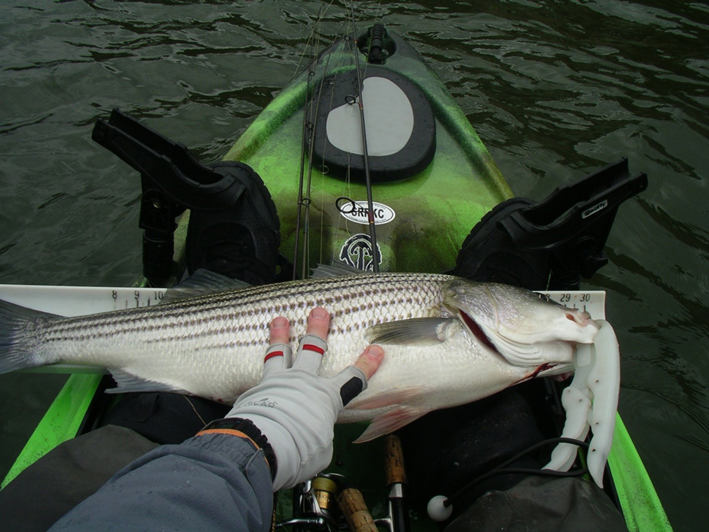Many kayak anglers, myself included, enjoy light tackle trolling for stripers from kayaks. Some anglers concentrate on deeper water, but kayak trolling in shallow water (often six feet or less) can be very effective. I use medium-light, medium, or medium-heavy spinning rods in six-foot or six and a half-foot lengths. Most often I troll with jigheads or bucktails trimmed with three- to five-inch paddle-tails. I don’t try to get lures to run exactly at a precise depth, which is very difficult to do especially in a human-powered vessel, but of greater importance is keeping the lures from hitting bottom and picking up debris.

There are several key factors that determine how deep your lure will run, which can be tweaked or adjusted by the angler:
Speed For lead-head and soft plastic lures, the faster the speed, the higher the lure will swim in the water column. When moving across a particularly shallow stretch, increase your speed to bring the lure higher and avoid contact with the bottom. Note that if you use a diving crankbait, a faster speed may cause the lure to run deeper in the water column.
Always remember that GPS units display speed over ground rather than speed through the water. When you paddle with a current, you’re going to move faster over ground than when you move against the current. But because the current is moving either with or against you, the lure may have the same relative speed through the water – even when the speed over ground is quite different.
There are differences of opinion about the "best" trolling speed or speed range. Some kayak anglers prefer very low speeds. I generally try to keep my speed in the range of 1.5 mph to 3.5 mph (with consideration for whether I am moving with or against the current). The stripers can easily find and attack a lure within that speed range. Depending on what lure you use, you want to make sure that it is swimming in a somewhat natural way at the speed you select.
Lure weight and shape When considering what lure weight to choose, think about the depth at which you’ll troll and where in the water column you’d like the lure to run. In addition to the weight, the shape of the lure will affect the depth it runs at. You need to experiment to see what works – and each day is likely to be different. When trolling in shallow depths (under six feet, for example,) I intentionally down-size lure weights (generally to a half-ounce or less) so the lures are not hitting the bottom. When trolling in intermediate depths (say, six to 20 feet,) I use a range of lure weights up to an ounce, to cover different depths.
Type of line I use 20-pound test braided line on all my kayak trolling setups. Braid is thinner and has less water-resistance than the same test line monofilament line, plus mono is buoyant. So when all else is equal, a lure on a braided line will run deeper than the same lure on a mono line of the same pound-test.
Length of line Longer lines equal deeper depths. I typically troll four lines from my pedal-drive Native Watercraft Slayer Propel 10 kayak. The two rear rods have heavier lures. I toss them out to the side with a full cast then close the bail. The two front rods have lighter lures. I toss them out with a half cast, then close the bail. This is not a quantitatively precise system, but it does provide enough separation of my lures that I rarely get tangles, and am able to cover different depths.
Rod Tip Elevation There will be a difference in elevation of the rod that’s near the gunwales and set up horizontally to the side compared to a rod that sticks up 45 or 60 degrees from horizontal, and this also affects the running depth of a lure. When you know there’s a shallow patch ahead you can grab the rod with the heaviest lure and the least elevation out of the rod holder and raise the tip to temporarily raise your lure in the water column.
- By John Veil, author of “Fishing in the Comfort Zone,” and Pro Staffer for Native Watercraft.
For more information on trolling from a kayak, be sure to read Kayak Trolling Tactics: Tracing the Contours. Other FishTalk articles that may be of interest to kayak anglers include:
Selecting the Best Fishing Kayak
Bonafide Kayak SS127: Cool New Yak